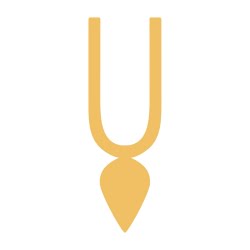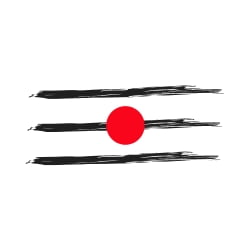In Hinduism, Tilak is a sign of honour that people wear to show their faith. It also helps people get out of the physical world. From what the Atharvana Upanishad says, anyone who puts on a tilak that looks like Lord Krishna’s lotus feet gets closer to the Paramatma or the Supreme Self. In Brahmaratra, it says that people should put vertical tilaks on their bodies, which would help them reach Sayujya freedom. Sanathana Dharm also emphasizes the importance of putting on Tilak or Tikka.
Tilak is mostly put on the face but can also be put on the neck, hands, and chest. It is very important to use tilak made from natural materials. Try to stay away from artificial alternatives because they can be bad for our faces and bodies. To make tilak, you need sandal wood or Chandan, turmeric, cow dung, clay, charcoal, vermillion, and ashes from Yajnas, more popularly called Vibudhi.
You can use your hand or a metal strip to put it on. Different things are good about putting tilak on with your fingers. For example, putting it on the ring finger can give the person peace, and putting it on the middle finger could make them live longer. Besides that, using tilak has several other perks as well.
Why Apply Tilak on Forehead?
Most of us put a tilak between our eyebrows at the top, where our Third Eye is. The Third Eye point can take us out of the material world and into the awareness of Brahman, which is beyond matter. According to the Tantras, three of our nadis meet on the forehead. Putting a tilak on the face helps us think more clearly and concentrate better. It can also make us feel better. Tilak is a holy sign that saddhus and other religious people wear. It also helps a person find their spiritual path.
The benefits of using tilak and why it’s important
Putting on a tilak is a sign of good luck and shows how important a religious practice is. Most of the time, people who worship Lord Krishna wear tilaks. The Vaishnava Sampradaya says that the tilak is a decoration that pleases the Lord. In the Shaiva tradition, the students wear tilaka made from the ashes of a fire (mostly yajnas). Adhi Yogis use ash from crematoriums, and people who live in their homes use ash from burning cow dung, sesame seed, and brown rice. Its use can make us more open and help us focus on more important things in life.
Different kinds of tilaks can also help in other ways.
Sandalwood: Putting sandalwood paste on your face makes you feel cooler. When it is dry, our Agnya Chakram pays attention to it. It also makes the pineal gland and pituitary gland work better. If you put the paste on while you meditate or pray, it can help you focus. Sandalwood tilak is a great way to reduce stress and help get rid of headaches.
Vermilion: It makes a person look more beautiful on the inside and gives them the energy to deal with different scenarios. It also helps us improve our ability to focus and wakes up our psychic powers.
Turmeric: When used to make a tilak, turmeric, which has antibacterial qualities, cleans our skin. It also helps calm our minds and gives us more confidence.
Types of Tilak on Forehead
Different groups use different kinds of tilaks. It depends on what they believe and what religion they belong to. People who honour Lord Krishna put tilaks on their foreheads to show how much they love him. Vaishnwa Samprathaya, which emphasizes the worshipping of Lord Krishna, is split into Brahma Sampradaya, Kumara Sampradaya, Rudhra Sampradaya, and Sri Sampradaya.
Vishnu Tilak

The first kind of Tilaka is worn by people who follow Vishnu. It is made of gopi Chandan and has straight lines that look like the letter “U.” This Tilak looks like the foot of Lord Vishnu. There might be a line in the middle, but that’s not always the case.
Brahma Sampradaya

It includes Madhva Sampradaya and Gaudiya Sampradaya.
Gopichandana, which you can get from Dwarka, can be used in the Madva Sampradaya to draw two vertical lines that look like the lotus feet of Lord Krishna. You can make a black line between these two vertical lines with the coal ashes left over from the Yajnas.
You can use mud from Vrindavan to make two straight lines in the Gaudiya Sampradaya. They look like Lord Krishna’s soft feet. You can connect these two lines at the bridge of your nose in the shape of a Tulsi leaf, Lord Krishna’s favourite plant.
Lord Shiva Tilak

People who follow Shiva use a different kind of Tilak. You will see Tripundra, which is three horizontal lines. People say that Shiva loves the Holy Ash or Bhasma used to make this Tilak. Some of the lines have a red dot, but not all of them do.
One more way to show that you are a Shiv Bhakti is to wear a crescent moon on your face. This represents the moon that Shiva wears on his head.
Kumara Sampradaya
Here, Gopichandana is used for making the tilak. You can start at the bridge of your nose and draw two vertical lines that meet in the middle of your forehead to make a U shape. In the middle, you can put a black dot made from the slate you got from Barsana. It shows that Krishna and Radha are there at the same time.
Bindi
As was already said, women wear different kinds of Tilakas, too. In India, for example, most married women wear a dot on their faces to show that they are married.
Rudhra Sampradaya
Here, the tilak is a single line going up and down. The red colour of the tilak comes from the kumkum, a picture of Yamuna Devi. In the Rudhra Sampradaya, Govardhana is the form of Lord Krishna that is honoured.
Shakti Tilak
People who follow Shakti wear a Kumkum dot on their foreheads. This dot represents Devi Parvati’s strong force.
Sri Sampradaya
Here, you can use the white mud from the anthills to make two lines. You can also use the dirt at the bottom of a tulsi plant. Both of them are seen as good. You can make a red line in the middle using the red stones in the anthills. It is a sign of the goddess Lakshmi Devi.
Raj Tilak & Veer Tilak
There are also Raj Tilak and Vir Tilak, different types of tilak. During the time of Rajyabhishek, Raj Tilak is a part of the event where a new king is crowned. The name “Vir Tilak” was used to describe brave people or to help people do well at any job. Hindu beliefs say that Tilaka is put on before starting something new as a sign of good luck.
In Summery
Tilak is a Hindu tradition that has been around for a long time. In Shaivism, using the smoke from Yajnas has something to do with how death is shown. It also shows how useless it is to hold on to material things because they are temporary. Putting tilak on your Third Eye can wake up your Agnya Chakra and make connecting with your Absolute Self easier. A tilak can help you clean up your religious and spiritual path.


Can men wear Maa Parvati way of Tilak..